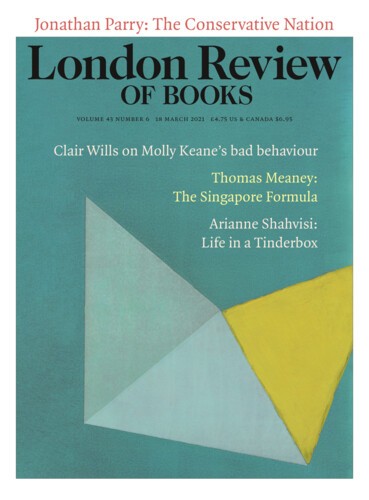The Musée des arts et métiers in Paris is the best place I know to see a full-size lion rendered in spun glass fibre or an aeroplane in the form of a bat, to watch an automaton show or to consider the uses, and potential drawbacks, of a bowler hat fitted with a spy camera. Founded during the French Revolution as an offshoot of the Conservatoire des arts et métiers, which had been set up in 1794 to train future generations of artisans, mechanics and inventors, the museum opened its doors in 1802. Since then, the material evidence of scientific and technical achievement has settled into comfortable retirement here, alongside delicious one-offs, bespoke gadgets and eccentric contraptions that didn’t quite hit the mark. Unusually for a museum of technology, there’s a sense that not much has changed since the early days. The collection bends more recent additions to its logic. Mobile phones, computers, Minitel terminals, and even the ubiquitous digital information screens dotted around the museum, seem just as archaic as their mechanical forebears, whose very strangeness can make them appear strikingly contemporary.
Unlike other Parisian institutions from the revolutionary era that self-consciously appropriated royal or religious buildings – the Louvre or the Panthéon, for example – the museum’s contents are in clear conversation with the space they occupy, the former monastery of Saint-Martin-des-Champs. In this temple of technology, founded by the polymathic Abbé Grégoire, spectacular machines are displayed as Enlightened replacements for religious mysteries. But the old magic persists, emanating now from secular marvels. Foucault’s pendulum dangles from the chapel ceiling – the museum features in Umberto Eco’s novel – watched over by one of several models of Bartholdi’s Statue of Liberty. The enchantment begins before one even reaches the museum: the platforms at Arts et Métiers métro station are a steampunk delight. Clad in copper sheeting pocked with portholes, they place the visitor directly inside Verne’s Nautilus or the interior of some antiquated scientific device.
The museum’s permanent displays contain many original scientific artefacts (Vaucanson’s loom, Volta’s battery, Lavoisier’s laboratory), relics whose purpose was to inspire emulation. It also houses many models, which were better suited to teaching. Some of these are relatively routine reduced-scale machines, technical devices or architectural fragments, while others are remarkable distillations of manufacturing or engineering processes. Recently on show in the exhibition Top Modèles: une leçon princière au XVIIIe siècle were ten such models from 1782 that represent the interiors of artisanal workshops. These were among the first objects to enter the museum: seventeen joined the collection in 1802, although it’s not known how many were made in total. Thirteen of them survive today. They were ordered from the engineer brothers Jacques-Constantin and Auguste-Charles Périer, and constructed by François-Étienne Calla, a former technician for Vaucanson. In his Tableau de Paris (1781-88), Louis-Sébastien Mercier described with enthusiasm the ‘curious and useful’ nature of this project, which was still then in progress. In the last years of the Ancien Régime the models were used by Caroline-Stéphanie-Félicité du Crest de Saint-Aubin, better known as Madame de Genlis, to educate the children of the duc de Chartres, soon to become the duc d’Orléans, placing him next in line to the throne after the king’s immediate family. Cosplaying as a man of the people following the outbreak of revolution, he changed his name to Philippe Égalité and in 1793 voted for the death of his cousin Louis XVI (he too would die at the guillotine later that year). In 1830, Philippe Égalité’s oldest son was put on the throne as King Louis-Philippe.
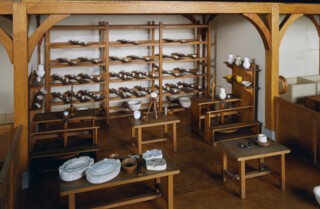
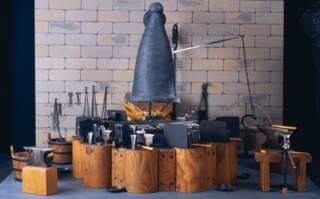
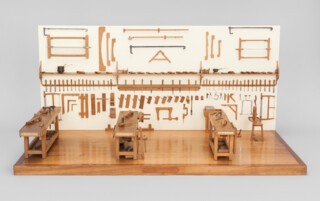
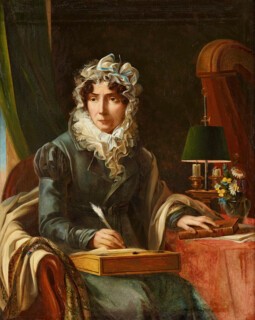
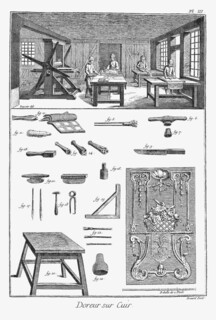
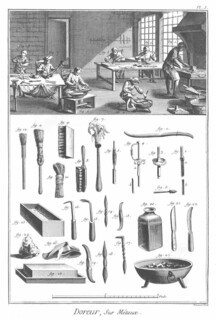
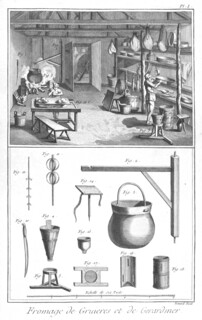
Domestic interiors reduced to a small scale are familiar. It is less often that we see a workplace submitted to the same kind of miniaturisation and scrutiny. Here, unobstructed by roofs or walls, the focus is as much on the tiny objects that populate the spaces as on the spaces themselves. Take the model representing a chemist’s laboratory, in which crucibles, stills, long-necked flasks and other receptacles in copper, glass, stoneware and wicker, each rendered with mind-boggling detail, fill shelves and cover workbenches. Or the model of a porcelain manufactory, one of three demonstrating the process of ceramic production, which displays moulds and wheels. Tiny pieces of unglazed porcelain line the racks behind. Each one of the model workshops – whether it represents a locksmith’s or a nail manufactory, a bullet foundry or the production of nitric acid – is made to the same 1/8 scale. Each one is meticulously constructed, reassuringly expensive and spotless. In none of them can any people be seen.
Madame de Genlis was made responsible for the education of the duke’s daughters in 1777, following a glittering rise through elite society and early acclaim for her virtuosic harp playing (the intricacy and precision of which seems consonant with the world of the models). In becoming tutor to the duke’s male heirs in 1782, she advanced into a different social and intellectual orbit. She established a reputation as an educational innovator, publishing Adèle et Théodore, ou Lettres sur l’éducation – a long epistolary novel that outlined many of her pedagogical principles and which was widely translated – later that year. Adèle et Théodore was influenced by Rousseau, whose Émile was still the pre-eminent treatise on education twenty years after its publication, but Genlis departed from him in several ways, most notably in advocating the education of girls. Her intensive and varied teaching methods were often visual in character. She took the young princes Louis-Philippe, Antoine and Louis-Charles, and their sister Adélaïde, plus several other children, including her own, to visit workshops and artists’ studios; paintings provided instruction in mythology, while magic lantern projections taught history and geography. This is the schoolroom for which the models were made, pioneering what schools and museums now call ‘object-based learning’.
The miniature manufactories that Calla created are modelled directly on the engraved plates for Diderot and d’Alembert’s Encyclopédie. As with those images, the conceit that the models might also serve trade specialists was disingenuous – they were meant for curious outsiders, rather than workers who already knew how to make an enamel or construct a cabinet, and there was no question of viewers getting their hands dirty. The dominant visual strategy in the Encyclopédie involves each vertical plate being split along a horizontal axis. The lower section shows the component objects (the locks, the nails, the bullets) laid out in shadowless white space, broken down to their essential elements and itemised with forensic specificity. The upper section of each plate comprises a vignette depicting the workshop in action. This ‘epic of substance’, Barthes writes in his essay on the plates, offers us for the first time an ‘autonomous iconography of the object’, the transition from raw materials to finished commodity accomplished with no greater force than turning the page. For Barthes, the Encyclopédie’s peaceful scenes and ordered arrangements of objects, materials and tools conceal a violence, a ‘wild surrealism’ that, whether we want it to or not, shows us the ‘wrong side of things’.
In Genlis’s models (and they are hers in spirit and practice), the workshop space and inventory of tools and objects – separated in the Encyclopédie – cohere into one scene. The models repair a fractured world of things, making it whole and intact. Yet there is no one there to disturb the calm. The happy artisans of the Encyclopédie in their tidy, evenly lit studios betray no hint of their labour. The stink of the tannery, the heat of the furnace, the grubby printer’s devils, are all expunged. But the models go a stage further, stripping these scenes of the last vestiges of human presence. They appear almost haunted, still lifes whose protagonists have just departed.
Whenever I think of the Musée des arts et métiers, my abiding memory is the sound of my own footsteps. The surprisingly loud creak of the varnished floors, many of them latticed with metal tracks for moving heavy machinery, accompanies visitors throughout the main galleries. The smaller squeaks are a constant reminder that we are in the company of objects that formerly sighed, hummed, clanged and buzzed (and also, perhaps, that the museum deserves more visitors). Of all materials, it is wood that dominates Genlis’s models. This is most obvious in the carpenter’s workshop, a mise-en-abyme of highly skilled precision woodwork. No ordinary carpenter worked here, but an ébéniste, someone adept in veneers or marquetry – the tools on the wall are those of a specialist. Barthes was quick to notice that the preponderance of wood in the machines of the Encylopédie had a humanising effect, making them seem like a series of ‘big toys’. But what happens when there’s no one there to play with them? For those of us confined to our homes all year, this is a particularly eerie thought. By the time we get back to our long-abandoned workplaces, they will probably seem as alien as these deserted stage sets, frozen in time and scrubbed clean by invisible hands.
Send Letters To:
The Editor
London Review of Books,
28 Little Russell Street
London, WC1A 2HN
letters@lrb.co.uk
Please include name, address, and a telephone number.
